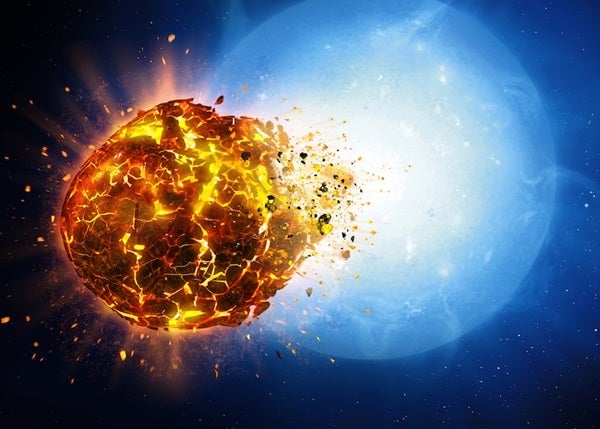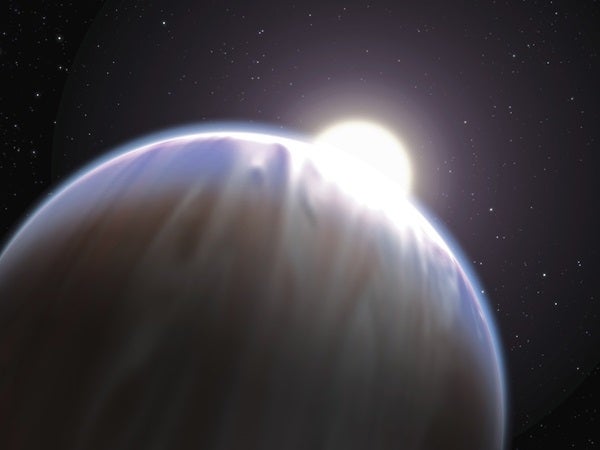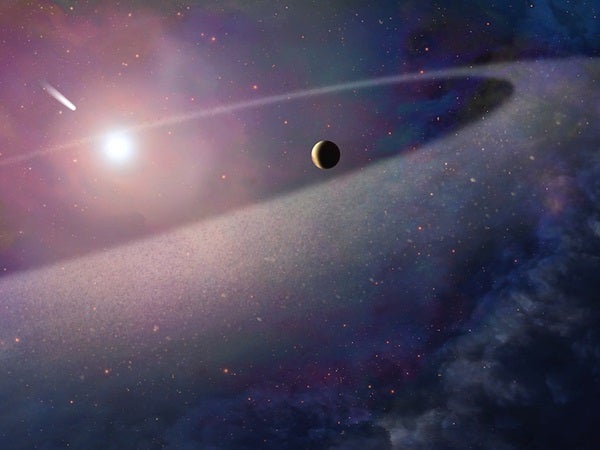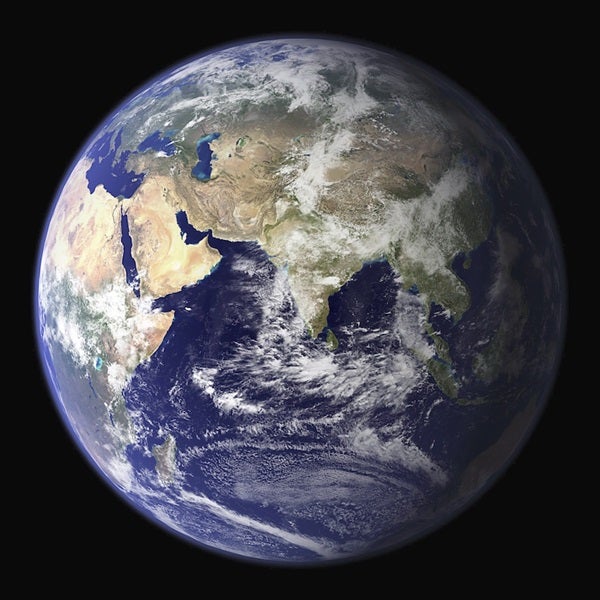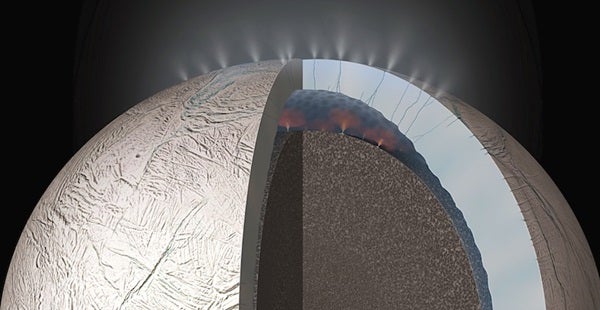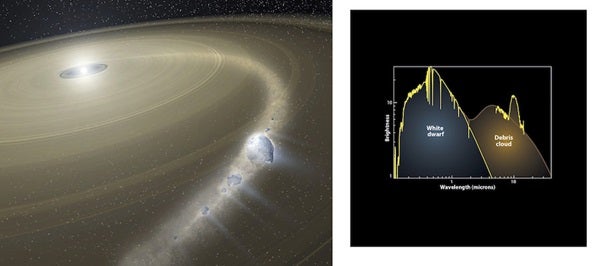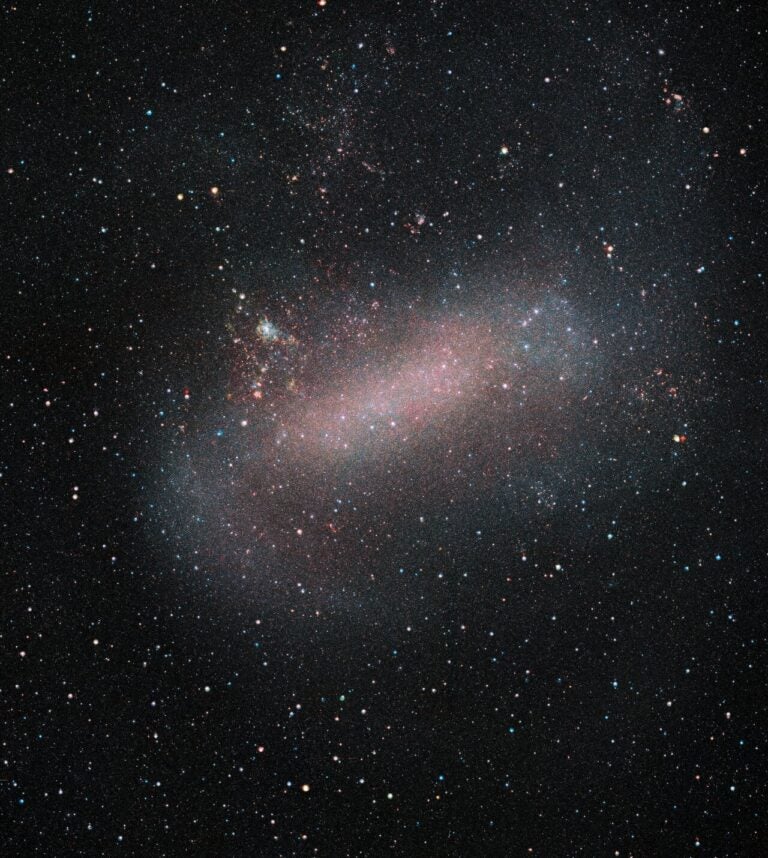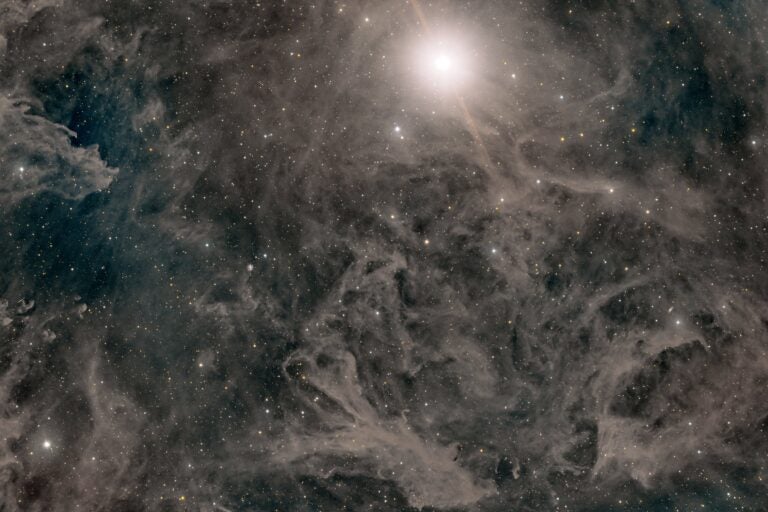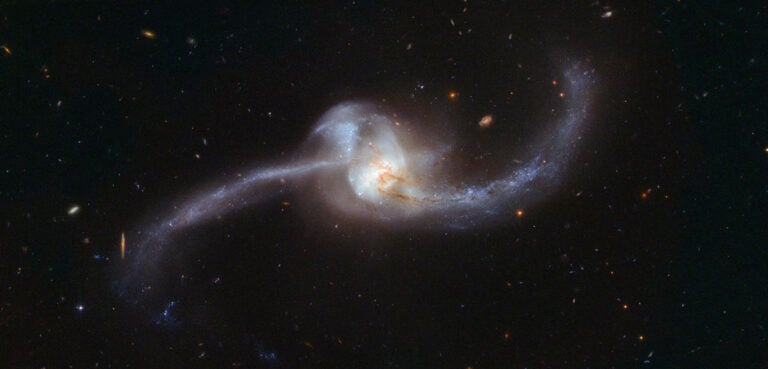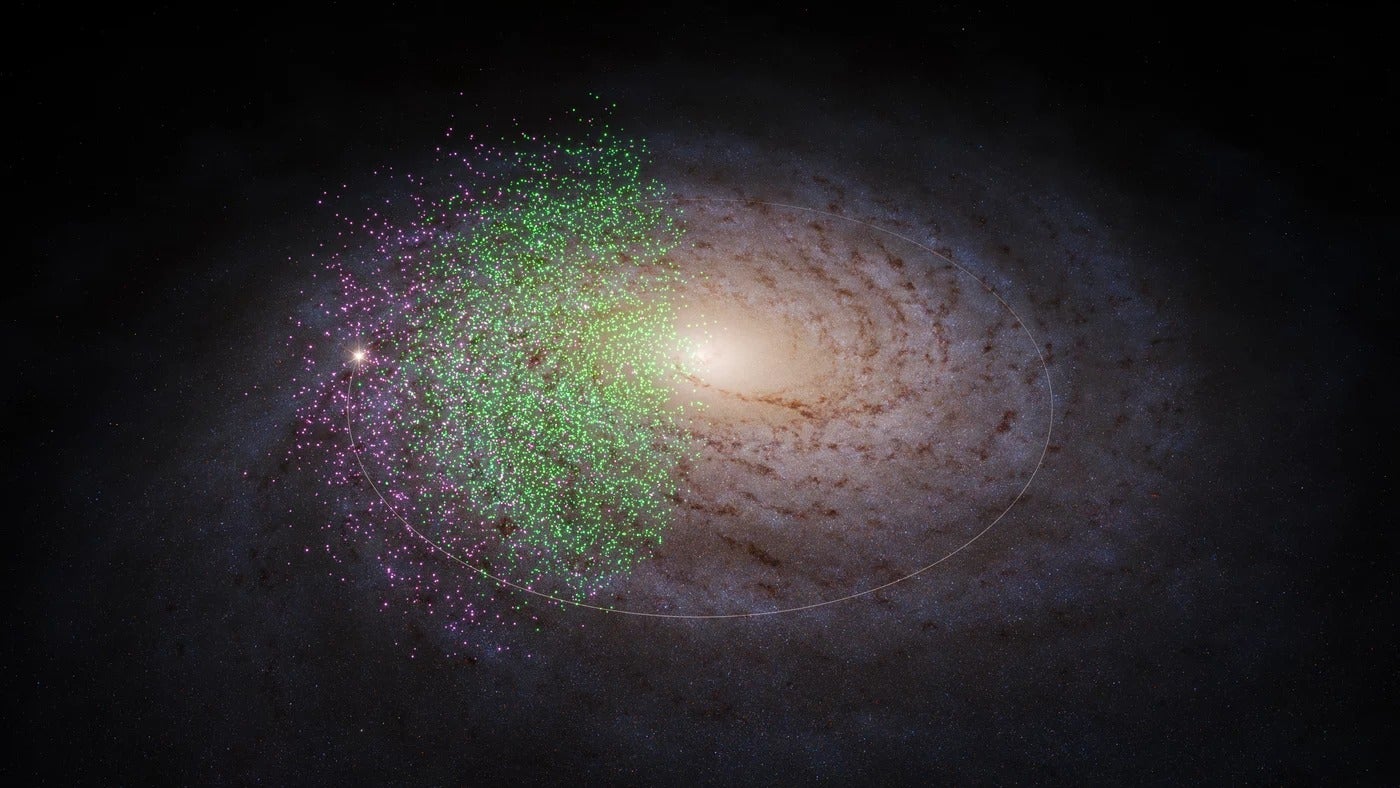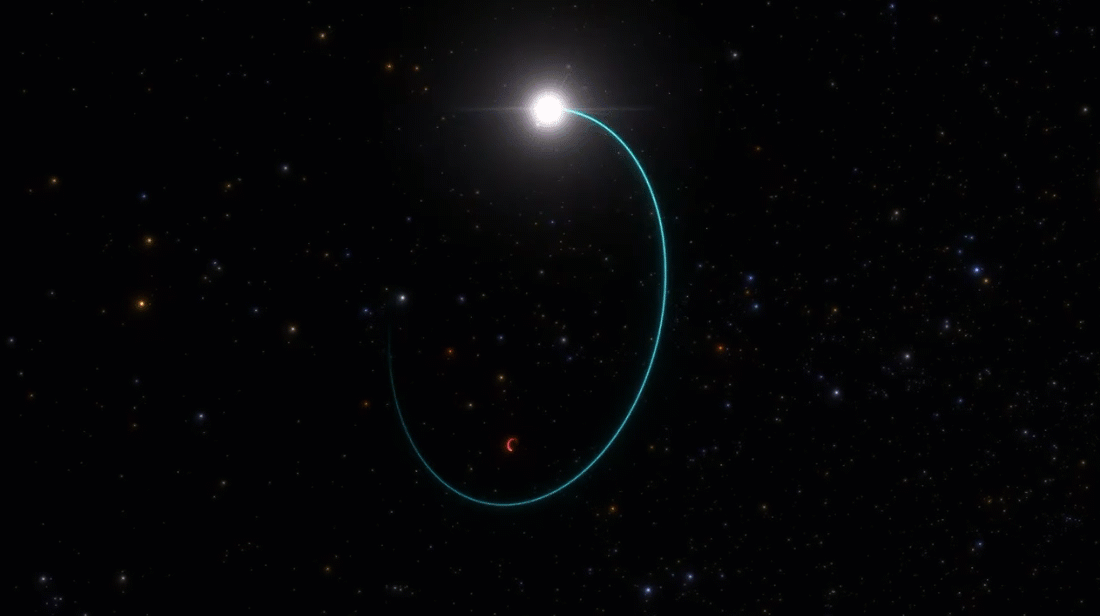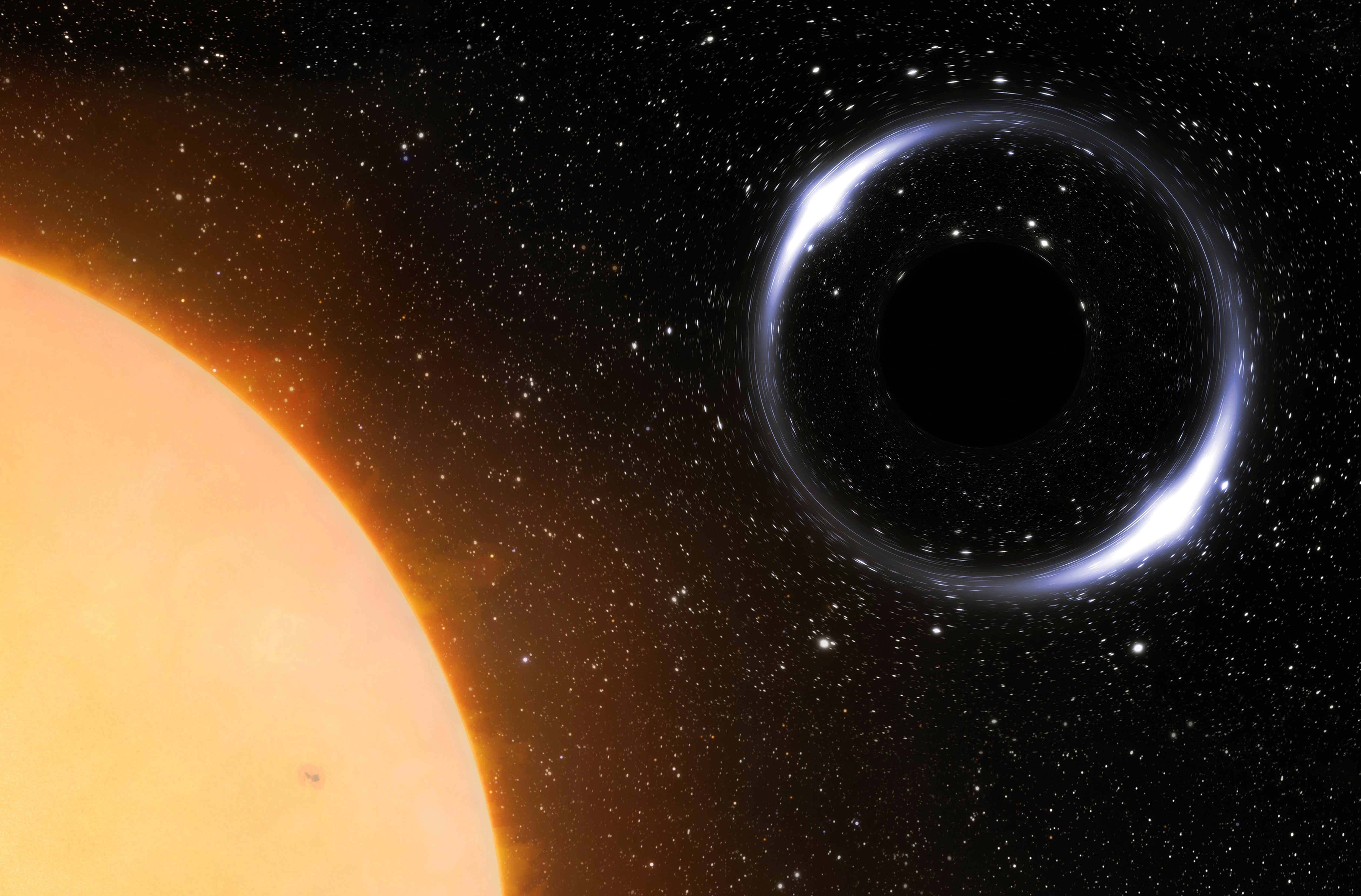For nearly a decade, scientists have probed the composition of planets as the worlds are shredded and consumed by white dwarf stars. Because heavy elements quickly sink below the hydrogen- and helium-rich stellar surface, any metals (all elements not hydrogen or helium) detected in the star must come from planetary debris falling into it. Thanks to this process, astronomers know more about the interiors of dead exoplanets than they do about Earth’s composition.
Uncharted waters
What, then, are scientists looking for? Water is the key ingredient for life on Earth. So, when we search for life on worlds in our solar system, water’s presence usually dictates our interest. It’s no surprise, then, that astronomers looking for potentially habitable worlds around other stars key in on the possibility of water.
Often, the search for exoplanets focuses on the habitable zone, the region around a star where water could stay liquid on a planet’s surface. Unfortunately, it will be a long time before any of our telescopes can resolve the surface of a world light-years away. Instruments like NASA’s Hubble Space Telescope probe other worlds, searching for signs of water in their atmospheres. But despite identifying thousands of planets and planet candidates beyond the solar system, scientists can glean only the thinnest of data about them.
Most of the identified planets were originally found and studied using the transit method, which examines how an object blocks light from the star. Unfortunately, this can provide only the size of the world. Others were found using the radial velocity method, which measures how much a planet tugs on its star, thus revealing its mass. If scientists follow up on a transiting world with a radial velocity measurement — and they have in many cases — then they can use the mass and size to calculate the planet’s average density, providing a rough estimate of its composition and perhaps a clue whether water is present.
But if Earth had formed dry, where did that water come from? For decades, scientists believed that comets were a strong contender. The rocky snowballs of the solar system could have crashed into the inner planets when everything was colliding in the violent early solar system, bringing not only water, but also other volatile materials like carbon and nitrogen. Unfortunately, missions to comets have revealed that the chemical fingerprint of their water doesn’t quite match up with Earth’s oceans, leading most researchers to shrug them off as a primary water source — although they may have contributed a fraction of our current supply.
Today, asteroids remain the strongest contender for the delivery of water to Earth. In the asteroid belt, water is locked up in minerals. If young Jupiter with its immense gravity stirred up material there, some may have hurtled inward. The collisions and resulting heat would have released the water onto the young Earth.
“Asteroids have enough water in them to give a nice wet surface layer to forming young rocky planets,” says Ben Zuckerman, who studies white dwarfs at the University of California, Los Angeles.
So, researchers are unraveling the mystery of how water got to Earth, and they assume a similar process worked for planets around other stars.
The key: white dwarfs
Exoplanets may be shrouded in mystery, but their remains are providing clues about their lives. Over the last decade, scientists have found a way to probe what lies inside an exoplanet, not from the outside in, but from the inside out. Such observations are providing a more detailed look at the composition of these bodies than studies of our closest worlds — including Earth.
“In the solar system, we don’t actually have a method to see into the interiors of planets,” says Jay Farihi, an astronomer at the University College London. “We don’t know, for example, 70 to 80 percent of Earth’s composition, even though we are standing on it.”
But in a way Farihi may be able to work around such tactics to study exoplanets. Rather than looking at the worlds themselves, he and his colleagues study white dwarfs — the remains of Sun-like stars that have retained much of their mass but are only the size of Earth. Some of these stars have consumed the worlds that once orbited them.
At the end of its life, when it can no longer fuse helium, a star like the Sun swells to become a massive red giant before releasing its outer layers as a planetary nebula. What’s left collapses into a white dwarf. These stellar corpses no longer fuse elements, but their high density and leftover heat means they’ll spend billions of years cooling.
Unlike stars, the atmospheres of white dwarfs are fairly pristine. Astronomers detect only hydrogen and occasionally helium, which rise to the top. Other material sinks quickly. So when scientists see something like carbon or nitrogen polluting the atmosphere, they know something falling onto the star must have delivered it.
“A white dwarf acts like a blank piece of paper,” Farihi says. “When stuff falls on there, we can see what it’s made of.”
And white dwarfs are voracious eaters. As material orbiting them draws closer, the object’s intense gravity shreds it. While Sun-like stars produce winds that drive gas away, the dead stars are silent, with no gales that can carry debris to freedom.
“Once you’re trapped in the gravitational field of a white dwarf, it doesn’t matter what form you’re in — eventually, you’re going to be gobbled up by that white dwarf,” Zuckerman said.
That’s when the science starts. Probing the outer layers of white dwarfs reveals the guts of their latest meals, consumed anywhere from 10,000 to 100,000 years earlier. Disks of debris surround white dwarfs. Recently, astronomers spotted a disintegrating Ceres-sized asteroid orbiting a white dwarf, suggesting that much of the material in its atmosphere could have come from the destroyed minor planet.
Because white dwarfs shred objects spiraling into them, it can be challenging to say whether material came from a full planet or just an asteroid-sized chunk. But over the past decade, observations of the last meals of white dwarfs have made it obvious that water is common in dying systems, suggesting it’s an ingredient in planets as well.
Minor planet meal
As it became more obvious that white dwarfs were snacking on dying worlds, many scientists wanted another look. In 2012, Farihi and his colleagues captured new images of the white dwarf GD 61, taking a more in-depth look with Hubble and the Keck I and II telescopes in Hawaii. After studying the chemistry of the white dwarf’s atmosphere, the team announced that GD 61 had recently eaten a water-rich object. For the first time, water was identified as a major ingredient in an object outside the solar system.
Uri Malamud and Hagai Perets, researchers at the Israel Institute of Technology, modeled what might happen to water both on and in an asteroid-sized object as its star swells into a red giant. They found that, for all but the most distant rocky bodies, any surface water probably evaporates and is driven off as the star becomes a giant. But water trapped in rocks could survive.
Since GD 61 was found consuming an asteroid-like object, a handful of other white dwarfs have shown the same eating habits. According to Boris Gänsicke, professor of physics at the University of Warwick, the white dwarf snacks spotted before this year all looked like objects from our inner solar system: rocky, iron-rich material that resembled the cores of busted-up planets, with only a handful carrying water. But rocky bodies from distant asteroid belts aren’t the only things white dwarfs are consuming.
In early 2017, a team led by Siyi Xu at UCLA found evidence that white dwarfs also have been consuming material from their outer solar systems. Xu has been using the Keck telescope to survey polluted white dwarfs, and she had worked with UCLA’s Michael Jura, whom she refers to as “a pioneer in this kind of work.” (Jura passed away in 2016.)
One of the objects, WD 1425+540, didn’t really stand out from the crowd except for one notable feature. Although it is a helium white dwarf (more about this type of object later), it is rich in hydrogen. When Xu studied the white dwarf with Hubble, she also discovered it is surprisingly rich in carbon and nitrogen, material that is rare close to a star, and that only shows up at distances equivalent to Saturn’s position in our solar system.
“Nitrogen is a signpost, or an indicator for low temperatures,” Zuckerman says. And where nitrogen exists, can water be far behind?
The high nitrogen content was a signal for Xu, now at the European Southern Observatory, who said that no other white dwarf had previously shown signs of accreting the element. The high quantity of nitrogen in comparison to other elements suggested that the destroyed object came from even farther out than a Saturn-like orbit, perhaps from an extrasolar Kuiper Belt. In our solar system, the Kuiper Belt is the home of comets and dwarf planets. Whatever WD 1425+540 was snacking on was bigger than a comet, weighing in at about the same mass as the Kuiper Belt’s most famous inhabitant, Pluto.
“We really don’t know the bulk composition [of Pluto],” Xu says. “You don’t know it until you smash it up and let us measure it.” So, the distant white dwarf may have provided the closest look we’ll get at the inside of one of the outermost worlds in our solar system.
Exo-Kuiper Belts aren’t new — scientists spotted them around other stars even before they knew the Sun had a belt of its own. But never before have they been able to peer inside of one.
“Now, for the first time we’re actually able to measure the elemental and chemical composition of an object that was once in an extrasolar Kuiper Belt,” Zuckerman says.
If the Sun’s Kuiper Belt tossed comets and other objects toward Earth, seeding it with at least some of the water and elements necessary for life, then an exo-Kuiper Belt rich in the same ingredients provides hope for other systems following a similar track.
The mere fact that such objects rich in volatiles orbit white dwarfs is encouraging. “Earth-like worlds, if they exist, might also have a veneer or surface layer that would be conducive for the origin of life,” Zuckerman says.
Helium white dwarfs make up roughly a third of all white dwarfs. Unlike their more plentiful cousins, they have atmospheres rich in helium rather than hydrogen. In fact, their source of hydrogen is something of a mystery. Some researchers contend that these white dwarfs formed with a reservoir of hydrogen that was gradually diluted by the helium atmosphere. Others wonder if the stars might have picked up hydrogen on their surfaces as they passed through interstellar material.
Fusillo and his colleagues recently discovered a new helium-rich white dwarf, GD 17, whose composition strongly resembled GD 61. Both are heavy in hydrogen and rich in other elements. Wondering if the two characteristics might be connected, Fusillo surveyed 729 helium white dwarfs. He found that hydrogen was nearly twice as common in polluted white dwarfs as in their counterparts.
What if the hydrogen in these rich white dwarfs was the only surviving sign of water-rich objects? As with GD 61, an asteroid or KBO may have crashed into the dying star. But while the oxygen, carbon, nitrogen, and everything else would eventually sink out of the atmosphere, the hydrogen would linger. Over time, it would pile up, leaving white dwarfs that had consumed water with an exceptionally thick hydrogen atmosphere.
Consuming planetary debris isn’t the only source of hydrogen in helium white dwarfs. Fusillo still thinks that a lot of white dwarfs probably retain traces of a primordial hydrogen atmosphere. But the debris definitely makes an important contribution. “A significant amount of them must have undergone this accretion event,” he says.
With no debris disk to provide additional clues, it’s impossible to tell if unpolluted hydrogen-rich helium white dwarfs devoured a few large planetlike objects or a wealth of tiny asteroids over their billion-year lifetime. “Hydrogen can look back in history, but that information is lost,” Fusillo says. “It could be separate events over time, each carrying a tiny amount of water over long scales of time.”
Farihi cautions against the possibility of overstating the link between water and hydrogen-rich atmospheres. With polluted objects like GD 61 and GD 17, it’s easier to make the case for water by matching up the signatures of the elements present. Once the elements have sunk into the star, however, all that’s left is water.
Testing the water
So while understanding living worlds remains a challenge, dead planets are slowly giving up their secrets. And it looks like their secrets could be very wet, indeed.
“There is evidence that water seems to be a general ingredient of planetary systems, even ones that have evolved to the very end of the lifetime of their host stars,” Gänsicke says.
Fusillo agrees. “Water is not rare,” he says. “Whenever a white dwarf is accreting rocks, it’s also accreting water. It’s a small amount, but very commonly present.”
If water is abundant not only in dead planets but also in living ones, that could be good news for those hunting potentially habitable worlds. Planets around living stars may also have received water, either from asteroids or comets, and may hold onto that water until the end of their lifetimes.
“If rocky planets form in the habitable zone, there are a sufficient number of water-carrying bodies that deliver material and make them habitable, even if they were not habitable in the first place,” Gänsicke says. “The kind of story that happened in the solar system is quite likely to happen in other planetary systems as well.”
Nola Taylor Redd is a freelance science writer who writes about space and astronomy while home-schooling her four kids.

